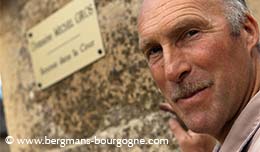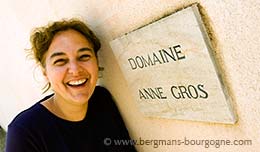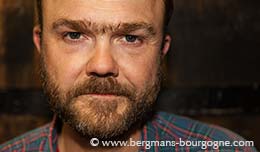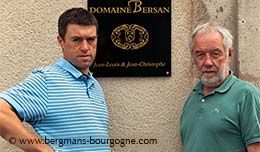
fter 30 years it was time for a change. The Lagarde family in Rosey decided it was time to spread their wings and produce their own wine. Three decades with the local cooperative came to an end and their first vintage saw the light of day in 2019, only to be met by a global pandemic.
– We didn’t share the ideas with the cooperative anymore, we no longer had the same expectations, explains Lucile Lagarde. We wanted to highlight our different vineyards. And in addition to that there was the new generation, me, who wanted changes. My parents were ready as well. We are happy with how it turned out.
Rosey is a small village in the Côte Chalonnaise, halfway between the Mâconnais and the Côte de Beaune. It counts just 160 inhabitants.
 – We are the only winegrowers in Rosey. You have Saint-Desert next door, where there are quite a few on the other hand. My parents had worked with the cooperative since 1987. My grandparents were farmers and they began renting vineyards, which they later bought. They brought the grapes to the cooperative. After 30 years with the cooperative my parents were looking for a change. I wanted to work with my parents, so we decided to give it a try and make our own wine.
– We are the only winegrowers in Rosey. You have Saint-Desert next door, where there are quite a few on the other hand. My parents had worked with the cooperative since 1987. My grandparents were farmers and they began renting vineyards, which they later bought. They brought the grapes to the cooperative. After 30 years with the cooperative my parents were looking for a change. I wanted to work with my parents, so we decided to give it a try and make our own wine.
But the transition from just producing grapes for the cooperative to producing wine under your own name requires a whole different setup. New premises were needed as Domaine Lagarde was born. They found the old priory in Rosey, which had been abandoned for more than 30 years. The roofs were beginning to collapse. Everything had to be renovated and a cuverie built.
 – I started out in tourism, says Lucile Lagarde. I then went to the UK for a year to learn English and work as an au-pair. I returned to Burgundy for a BTS en alternance in Beaune in order to be able to work at the domaine and learn more about vinification, because my parents didn’t know much at all about that part of the process.
– I started out in tourism, says Lucile Lagarde. I then went to the UK for a year to learn English and work as an au-pair. I returned to Burgundy for a BTS en alternance in Beaune in order to be able to work at the domaine and learn more about vinification, because my parents didn’t know much at all about that part of the process.
The first vintage for Domaine Lagarde was 2019. When the bottles were ready to be sold the following year the COVID-19 pandemic was in full swing.
 – There were no wine fairs, says Lucile Lagarde. The professional buyers didn’t know where things were heading, so they didn’t buy any wine. As a result we sold most of our 2019s at the cellar door. Thanks to that we became known locally. When COVID-19 disappeared we could start developing the other markets.
– There were no wine fairs, says Lucile Lagarde. The professional buyers didn’t know where things were heading, so they didn’t buy any wine. As a result we sold most of our 2019s at the cellar door. Thanks to that we became known locally. When COVID-19 disappeared we could start developing the other markets.
Domaine Lagarde has 28 hectares of vineyards. All are in the Côte Chalonnaise. There is some village appellation wine, Montagny premier cru and Mercurey, but much is focused on the regional appellation Bourgogne Côte Chalonnaise, both red and white. There is also Bourgogne Aligoté and Crémant de Bourgogne.
– Our Bourgogne Aligoté, Le Petit Pèlerin, comes from a vineyard which is around 60 years old. We use cordon pruning, which gives us small grapes which ripen better. It is vinified for six months. 50 per cent barrels, 50 per cent stainless steel tanks. The barrels are not new and two are oak barrels, two are acacia. It gives bit of roundness at the end, with slightly less acidity.
 The vineyard is in Chenôves, not to be confused with Chenôve (spelt without an ”s”} south of Dijon and part of the Marsannay appellation. Chenôves is four kilometres south of Montagny-lès-Buxy.
The vineyard is in Chenôves, not to be confused with Chenôve (spelt without an ”s”} south of Dijon and part of the Marsannay appellation. Chenôves is four kilometres south of Montagny-lès-Buxy.
– We have many of our vineyards down there, and it’s because my parents live there, says Lucile Lagarde. They started out in Chenôves. Then we have one parcel Montagny premier cru in Saint-Vallerin. One parcel of chardonnay for our Bourgogne Côte Chalonnaise in Jully-lès-Buxy. It’s a parcel my father inherited from his parents. It was just a meadow. He planted the vines 30 years ago.
– Then we have one parcel here at the domaine, Le Clos de Prieuré. We uprooted and replanted it, because it had been completely abandoned and was not producing much. And we have a vineyard in Mercurey. All in all, we have a good selection of parcels across the Côte Chalonnaise.
 The Bourgogne Côte Chalonnaise at Domaine Lagarde comes in five versions. Three red and two white.
The Bourgogne Côte Chalonnaise at Domaine Lagarde comes in five versions. Three red and two white.
– The Bourgogne Côte Chalonnaise appellation is not well-known, but things are improving, says Lucile Lagarde. Especially in France. There is more work to be done in terms of educating people about the appellation. The price/quality ratio is very good.
The standard cuvée in white comes from the parcel in Jully-lès-Buxy. Élevage is one year and 500-litre barrels are used, none of which are new.
– The freshness of the chardonnay, the fruit, is what I’m looking for in this cuvée, says Lucile Lagarde. The other white Bourgogne Côte Chalonnaise, the Clos de Chenôves, is different in that it sees 100 per cent new oak. It is more powerful. Really toasty, with a bit of vanilla.
 In total Domaine Lagarde has five hectares of Clos de Chenôves. Two hectares are planted with chardonnay and three with pinot noir. As the name suggests this is a walled vineyard. It is not entirely closed, three of the four walls remain today. Inside this clos you have deep clay-limestone soil.
In total Domaine Lagarde has five hectares of Clos de Chenôves. Two hectares are planted with chardonnay and three with pinot noir. As the name suggests this is a walled vineyard. It is not entirely closed, three of the four walls remain today. Inside this clos you have deep clay-limestone soil.
– The pinot noir vines are 65-70 years old. It produces a wine which has more tannins than the Clos du Prieuré, where the vines are much younger. All our reds are vinified in barrels. For the Clos du Prieuré it is mainly barrels that have been used for two or three wines before. For the Clos de Chenôves there is a little bit of new oak, while the rest are barrels used for one or two wines. This cuvée ha a bit of a smoky character. Then there is the old vines cuvée, the Bourgogne Côte Chalonnaise, Vieilles Vignes. It is a blend of our two oldest parcels, planted in 1956 and 1960. This one has a more peppery, spicy side.
 The Mercurey vineyards at Domaine Lagarde follow the same pattern, with both chardonnay and pinot noir next to each other in the same plot.
The Mercurey vineyards at Domaine Lagarde follow the same pattern, with both chardonnay and pinot noir next to each other in the same plot.
– It’s the lieu-dit Les Rochelle, says Lucile Lagarde. It’s opposite C.I.F.A., the school, when you exit Mercurey towards Aluze. On your right, after the pine forest. The vineyard is facing straight south, so it is a warm place.
Also the two Montagny premier crus – Les Coères and Les Chaniots – are right next to each other. But while Les Coères is in the commune of Saint-Vallerin, Les Chaniots is in the commune of Jully-lès-Buxy.
– It is one year of élevage for Les Coères, says Lucile Lagarde. 50 per cent barrels, 50 per cent stainless steel tanks. Half of the barrels are new, half have been used for one wine. That allows to keep the minerality of the Montagny, with a toasted touch.
– Les Chaniots is a bit more buttery than Les Coères, she continues. Vinified 100 per cent barrels. It is a very small cuvée. Just 300 bottles. It’s the same type of terroir as Les Coères, so in order to differentiate it is 100 per cent barrels. No new oak.
– In both cases the soil is clay and limestone. Both are mid-slope. In character Les Coères is a little bit more mineral.
Since 2019 Domaine Lagarde is certified HVE level 3, the certification created by the French Ministry of Agriculture in 2011. HVE stands for Haute Valeur Environnementale and it does not only take into account what is done in the vineyards, but also all other environmental aspects of the domaine.
© 2025 Ola Bergman














